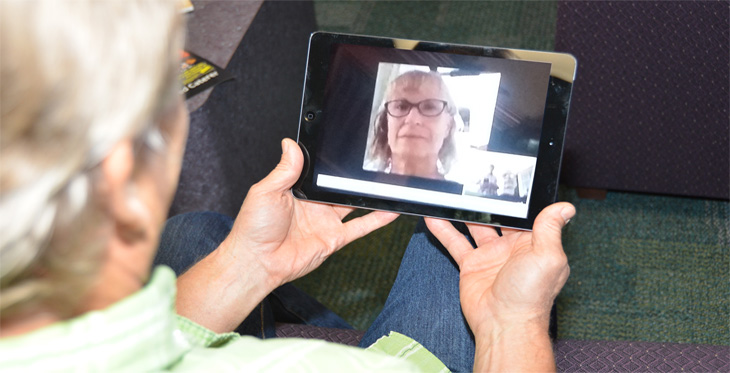I am an assistant professor at the University of Arizona, College of Nursing, a full-time position that includes research in my chosen field of health care systems and informatics, in which I have a PhD.
I also work one day a week as a hospice nurse, providing palliative care, which is focused on comfort and quality of life for patients nearing the end of life.
The “hands-on” care that is the hallmark of palliative care is often perceived to be in opposition to the “hi-tech” world of informatics. My recent experiences have shown that’s not the case.
With an innovation grant from the Arizona Telemedicine Program, I’ve researched the feasibility of using computer tablets, such as iPads, to enhance communication between hospice patients and caregivers, and their hospice nurse.
The importance of time is critical when providing hospice care, and I have found that technology can be used effectively to address time and communication concerns. For many years I was an on-call nurse, and would go out to see patients who I didn’t know during a crisis. Most commonly, patients were experiencing breakthrough symptoms such as pain, breathlessness, anxiety or nausea, which occur between doses of the patient’s scheduled medications.
I will describe an all too familiar scenario. The visits occurred primarily at nights and on weekends. A family caregiver would call when they had done all they knew to do, and yet their loved one was experiencing extreme breakthrough symptoms. The family member was often experiencing anxiety as well. Not surprisingly, the circular relationship between symptoms creates a horrifying escalation. Sometimes that escalation results in the family taking a patient who wishes to die at home to the emergency department, or calling 911.
This reaction never has good outcomes. As we all know, feelings seem to be worse at night. The on-call nurse immediately talks to the caregiver who calls for help, but the caregiver may feel that the on-call nurse doesn’t really understand. After all, they have never met.
The caregiver also realizes he or she is anxious, and may not be providing an accurate description of the patient’s circumstances. The nurse calmly explains to the caregiver that there is medicine in the house – routine procedure when patients are in hospice – and that the medicine is available just for these times.
“Oh yes,” the caregiver remembers that when the hospice program first started something like that was delivered and explained, but those medications have never been used. The on-call nurse continues to speak calmly into the phone, attempting to walk the caregiver through how the medications can be used, meanwhile hearing that the caregiver is stressed.
The nurse tells the caregiver that she will be at the house as soon as she can, but she is on the other side of town about 25 miles away.
Many times caregivers are fearful of administering an unknown medicine – what if they do something wrong and the patient dies? Yet, waiting means that the symptom escalation will continue.
Now here is the same scenario but with telehealth technology – for example, an iPad with meeting software such as Skype installed. The patient and family practice meeting using the real-time video tablet occasionally during their routine visits with the regular nurse.
When the nighttime symptom breakthrough occurs, the use of the telehealth technology is familiar. The on-call nurse remotely meets the family caregiver when they call for help using the electronic tablet. The nurse instructs the caregiver to show the patient, medications and home environment on the electronic tablet.
The on-call nurse notices that the chair is sitting on the oxygen tubing and recommends moving the chair. Even after that change, the patient is breathless, so once the patient is properly positioned, the nurse asks to see the medication that has been put aside for breakthrough breathlessness. The caregiver is then instructed on how to use the syringe for liquid medication delivery, being assured by the nurse that the proper amount of medication is being used.
The nurse remotely stays with the caregiver and patient until the medication takes effect. Then the nurse begins the journey across town to get to the home. By the time the nurse arrives at the home, the patient can be assessed for medication effectiveness. The nurse can adjust titration of the correct amount in case the breakthrough happens again.
Time and communication are vital when patients and their caregivers are suffering. The use of mobile telehealth is not intended to replace the “hands-on” visit, but rather improve care by adding immediate remote visualization to the usual communication that uses hearing and speech to provide comfort. In my practice, telehealth visualization has significantly enhanced comfort care during an on-call crisis.
Photo credit: Angelette Holtrust

